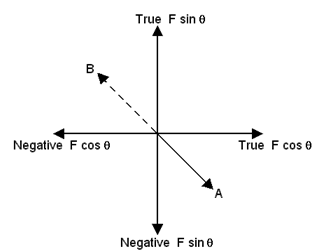Resolution of Forces by Calculation:
One vector was resolved into two mutually perpendicular components.

So if there are several vectors each can be resolved into two components.
e.g. F1 in directionθ1, gives F1 sinθ1, and F1 cosθ1
F2 in directionθ2, gives F2 sinθ2, and F2 cosθ2
F3 in directionθ3, gives F3 sinθ3, and F3 cosθ3
etc.
Once the components have been resolved, they can be added to give a total force in the Datum direction, and a total force perpendicular to the Datum.


These additions can be done laborio
usly 'by hand' but the modern scientific calculator renders this unnecessary.
Each vector should be entered and multiplied by the cosine of its direction and added consecutively to arrive at a total, F cosθ.
This procedure should be repeated, by multiplying each vector by the sine of its direction, and added consecutively to give F sinθ.
To calculate the Magnitude of the resultant,
Add (F sinθ )2 + (F cosθ)2 (= F2)
And find the square root of the addition (=F)
To calculate the Direction of the resultant,
Divide (F sinθ ) by (F cosθ) (= Tanθ)
and find the Angle (direction) that has that resultant,

Note that the values of sine and cosine take both positive and negative values, depending on the direction.
The calculator automatically takes account of this during the procedure.
The only occasion when ambiguity can arise is when finding the angle of the direction (there may be an error of 180º). This can be resolved by inspection. Note the following:

With reference to the ambiguity of direction,
note that  = (A) gives the same angle (direction) as Fsinθ/-FCosθ = (B). Thus, F sinθ and F cosθ have to be inspected to see which is negative. Solution (A) or (B) can then be selected.
= (A) gives the same angle (direction) as Fsinθ/-FCosθ = (B). Thus, F sinθ and F cosθ have to be inspected to see which is negative. Solution (A) or (B) can then be selected.
Similarly, Fsinθ/FCosθ gives the same result as -Fsinθ/-FCosθ .
Again, inspect the values of F sin q and F cosθ to see whether both are positive or negative.